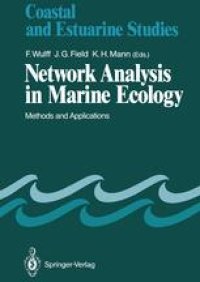
Ebook: Network Analysis in Marine Ecology: Methods and Applications
- Tags: Ecology
- Series: Coastal and Estuarine Studies 32
- Year: 1989
- Publisher: Springer-Verlag Berlin Heidelberg
- Edition: 1
- Language: English
- pdf
This book arises from a workshop on the application of network analysis to ecological flow networks. The purpose is to develop a new tool for comparison of ecosystems, paying particular attention to marine ecosystems. After a review of the methods and theory, data from a variety of marine habitats are analyzed and compared. Readers are shown how to calculate such properties as cycling index, average path length, flow diversity, indices of ecosystem growth and development and the origins and fates of particular flows. This is a highly original contribution to the growing field of ecosystem theory, in which attention is paid to the properties of the total, functioning ecosystem, rather than to the properties of individual organisms. New insights are provided into the workings of marine systems.
This book arises from a workshop on the application of network analysis to ecological flow networks. The purpose is to develop a new tool for comparison of ecosystems, paying particular attention to marine ecosystems. After a review of the methods and theory, data from a variety of marine habitats are analyzed and compared. Readers are shown how to calculate such properties as cycling index, average path length, flow diversity, indices of ecosystem growth and development and the origins and fates of particular flows. This is a highly original contribution to the growing field of ecosystem theory, in which attention is paid to the properties of the total, functioning ecosystem, rather than to the properties of individual organisms. New insights are provided into the workings of marine systems.
This book arises from a workshop on the application of network analysis to ecological flow networks. The purpose is to develop a new tool for comparison of ecosystems, paying particular attention to marine ecosystems. After a review of the methods and theory, data from a variety of marine habitats are analyzed and compared. Readers are shown how to calculate such properties as cycling index, average path length, flow diversity, indices of ecosystem growth and development and the origins and fates of particular flows. This is a highly original contribution to the growing field of ecosystem theory, in which attention is paid to the properties of the total, functioning ecosystem, rather than to the properties of individual organisms. New insights are provided into the workings of marine systems.
Content:
Front Matter....Pages i-viii
Front Matter....Pages 1-1
The Need to Analyze Ecological Networks....Pages 3-12
Front Matter....Pages 13-13
A Detailed Guide to Network Analysis....Pages 15-61
Construction of Flow Networks Using Inverse Methods....Pages 62-81
A Generic Simulation Model for Treating Incomplete Sets of Data....Pages 82-89
Dealing with the “Mixed Units” Problem in Ecosystem Network Analysis....Pages 90-115
Front Matter....Pages 117-117
Network Information Indices with an Estuarine Model....Pages 119-131
Network Analysis of Simulated Succession after an Upwelling Event....Pages 132-158
Derivation and Analysis of Flow Networks for Open Ocean Plankton Systems....Pages 159-205
Network Analysis of the North Inlet Salt Marsh Ecosystem....Pages 206-219
Analysis of the Flow Network in an Estuarine Benthic Community....Pages 220-231
A Comparative Anatomy of the Baltic Sea and Chesapeake Bay Ecosystems....Pages 232-256
Front Matter....Pages 257-257
Network Analysis in Marine Ecology: An Assessment....Pages 259-282
Back Matter....Pages 283-287
This book arises from a workshop on the application of network analysis to ecological flow networks. The purpose is to develop a new tool for comparison of ecosystems, paying particular attention to marine ecosystems. After a review of the methods and theory, data from a variety of marine habitats are analyzed and compared. Readers are shown how to calculate such properties as cycling index, average path length, flow diversity, indices of ecosystem growth and development and the origins and fates of particular flows. This is a highly original contribution to the growing field of ecosystem theory, in which attention is paid to the properties of the total, functioning ecosystem, rather than to the properties of individual organisms. New insights are provided into the workings of marine systems.
Content:
Front Matter....Pages i-viii
Front Matter....Pages 1-1
The Need to Analyze Ecological Networks....Pages 3-12
Front Matter....Pages 13-13
A Detailed Guide to Network Analysis....Pages 15-61
Construction of Flow Networks Using Inverse Methods....Pages 62-81
A Generic Simulation Model for Treating Incomplete Sets of Data....Pages 82-89
Dealing with the “Mixed Units” Problem in Ecosystem Network Analysis....Pages 90-115
Front Matter....Pages 117-117
Network Information Indices with an Estuarine Model....Pages 119-131
Network Analysis of Simulated Succession after an Upwelling Event....Pages 132-158
Derivation and Analysis of Flow Networks for Open Ocean Plankton Systems....Pages 159-205
Network Analysis of the North Inlet Salt Marsh Ecosystem....Pages 206-219
Analysis of the Flow Network in an Estuarine Benthic Community....Pages 220-231
A Comparative Anatomy of the Baltic Sea and Chesapeake Bay Ecosystems....Pages 232-256
Front Matter....Pages 257-257
Network Analysis in Marine Ecology: An Assessment....Pages 259-282
Back Matter....Pages 283-287
....